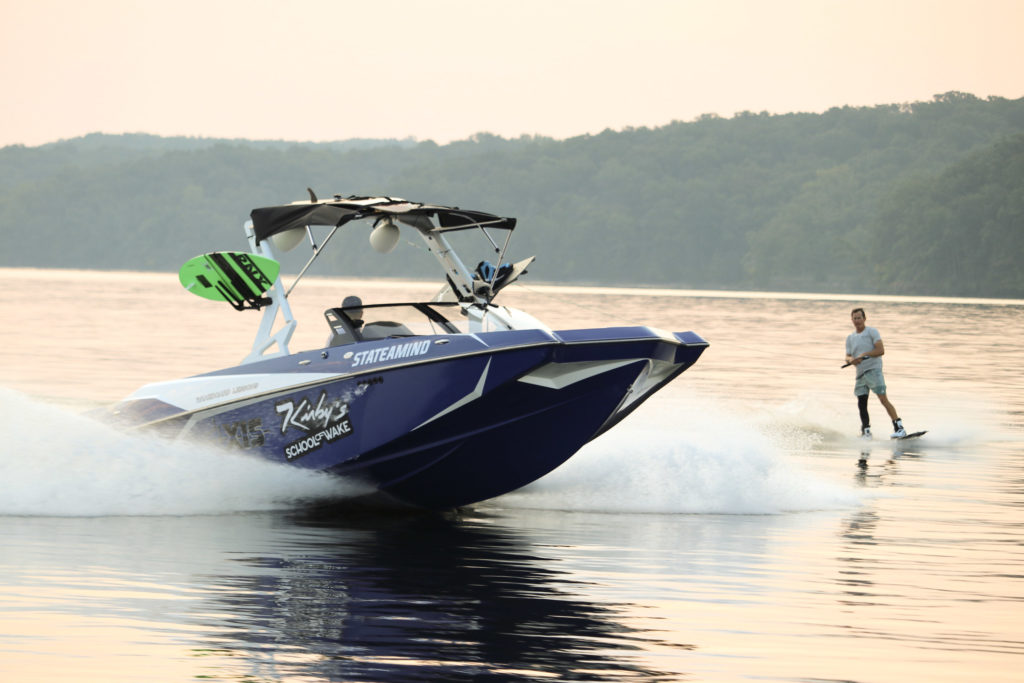
Photos by Sydney Liesmann, courtesy Kirbys School Of Wake
Teaching hundreds of kids to wakeboard every year, Kirby’s School of Wake has a few tips on learning for the first time.
by Sydney Liesmann
It’s another weekend at the Lake with friends and family, and wakeboarding sounds like just the thing after several fun tubing excursions. The old board is dug out from the dock locker, everyone excitedly loads the boat, and you’re off to find a good ski spot.
Everyone takes a turn attempting to squeeze their feet into the slightly dry-rotted rubber bindings until finally Dawn Soap comes to the rescue and wet feet are finally secured to the board. What follows next is usually a circus of voices yelling out well-meaning tips from the boat, as it circles around to pick up the fallen rider – again and again. Excitement quickly descends to frustration as little to no success is achieved. Can you relate? If so, don’t despair!
Compared to traditional skiing, wakeboarding and the increasingly popular wakesurfing are relatively new sports. Wakesurfing allows you to surf an ocean-style wave behind a wake specific boat with no rope. Pretty amazing stuff! But for those just starting out in the world of watersports, at Kirby’s School of Wake, we always suggest beginning with wakeboarding.
Contrary to popular belief, wakeboarding is for all ages and ability levels. It can be done at much slower speeds than traditional skiing and there are endless skills that can be learned at low impact.
Success on the wakeboard is determined by four variables: the boat, equipment, driver/rider synergy, and technique.
The Boat
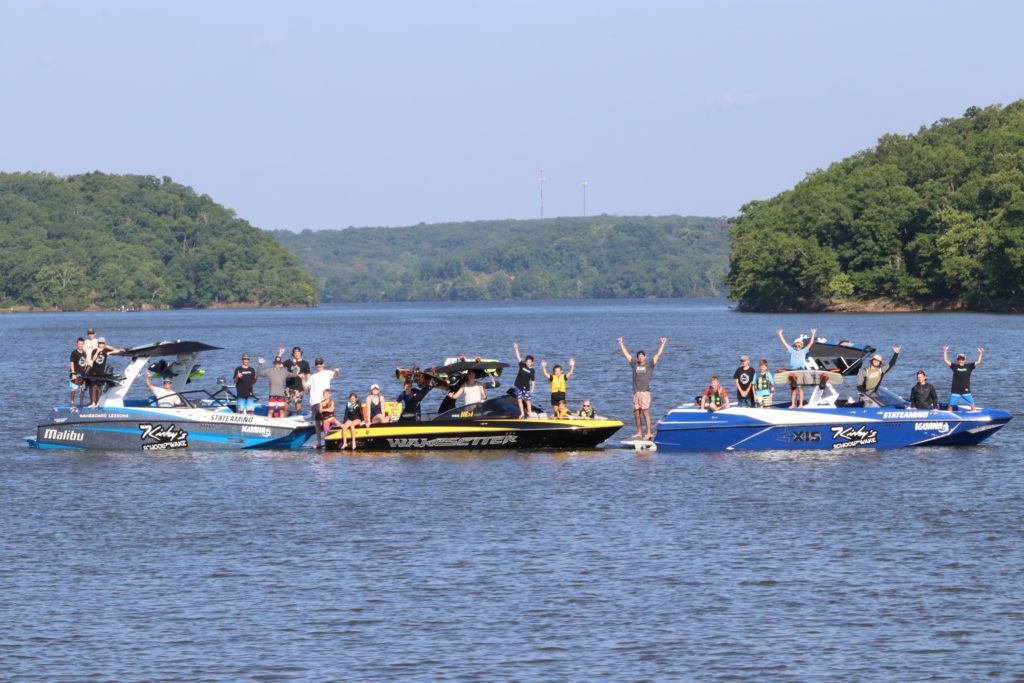
Photo Provided
A watersports-specific boat with a v-drive engine design creates an ideal environment for beginner wakeboarders. These boats come with a ski tower (which helps pull the wakeboarder upwards), speed control, and internal ballast wake-shaping capabilities.
If you don’t have that, don’t worry! The great thing about wakeboarding is it’s done on a long rope length, which means you can learn on most vessels under 28ft! This even includes a jet ski, although wakeboarders will soon feel limited behind a PWC.
Wakesurfing on the other hand, must be performed only on a wakeboarding specific boat complete with a surf system. An ideal surf system has a device mounted on the side of the boat, functioning as a wedge, redirecting and shaping water to form the perfect wave. Brands such as Malibu and Axis integrate this system in their boats, while others are added aftermarket.
Warning: Please DO NOT attempt to surf behind outboard boats, as this is extremely dangerous and potentially deadly!
The Equipment
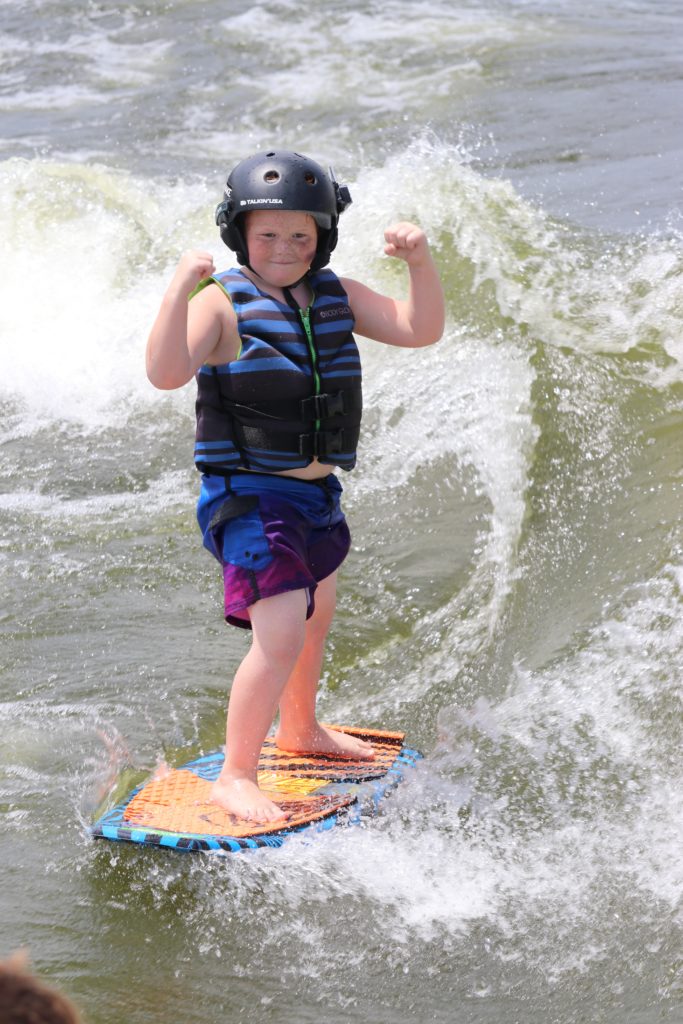
Photo Provided
If your boat meets the above criteria, the next thing you’ll need is the right equipment, which can make all the difference in having a good experience.
A good beginner wakeboard has a middle fin for stability, bindings properly sized to your feet, secure ankle support, and is the correct length according to your height. Not all wakeboards are created equal. If you need help finding a new or used board, our experts love helping outfit beginners!
Second, find a wakeboard-specific rope. These are nylon, non-stretch ropes with a plastic coating. Tension created by non-stretch ropes gives wakeboard riders stability on the water, and the capability to accomplish advanced tricks later on.
Last, but definitely not least, make sure you are using a USCG, Coast Guard Approved Life Jacket. Though competition vests look attractive and sporty, and may lightly keep you afloat, when put to the test these will not keep your head above water if you are injured. These are intended for competing professionals and are not safe for recreational use. A Coast Guard Approved vest will ensure your safety on the water, and safety is of utmost importance when wakeboarding.
Driver/Rider Synergy
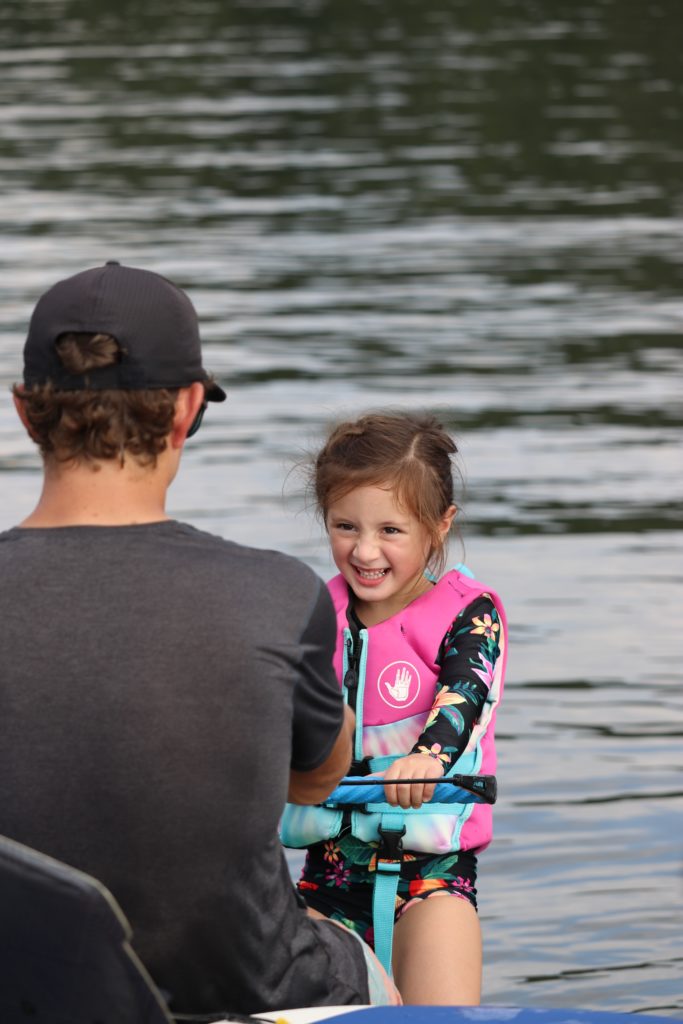
Photo Provided
Communication, understanding, and trust between rider and driver are key to maintaining a calm, pleasant experience for both. It’s important to know the standard hand signals, or use a Bluetooth System like BbTalkin’ Intercom to communicate and create a sense of trust between driver and rider.
More often than not, we see drivers assume the faster they go out of the gate, the quicker and easier the rider will get out of the water. This is not a safe or effective approach. It puts unnecessary strain on the skier, and if they do get up, this aggressive technique is more likely to cause the rider to take a hard slam.
At Kirby’s School of Wake, we use a three-speed technique for our starts. With the correct form as we will discuss next, this driving technique will work for any beginner wakeboarder:
- Put the boat into gear to get the student lined up behind the boat and make sure the rope is taut.
- Move the boat forward—very slowly—to make sure the student is in the correct body position, where you see them start to rise out of the water. (For wakesurfing, you want to see the board flip up to their feet)
- Once the rider’s board has surfaced on the water, slowly accelerate to approximately 12-18 mph for a beginner, maintaining a constant speed or using speed control.
Technique
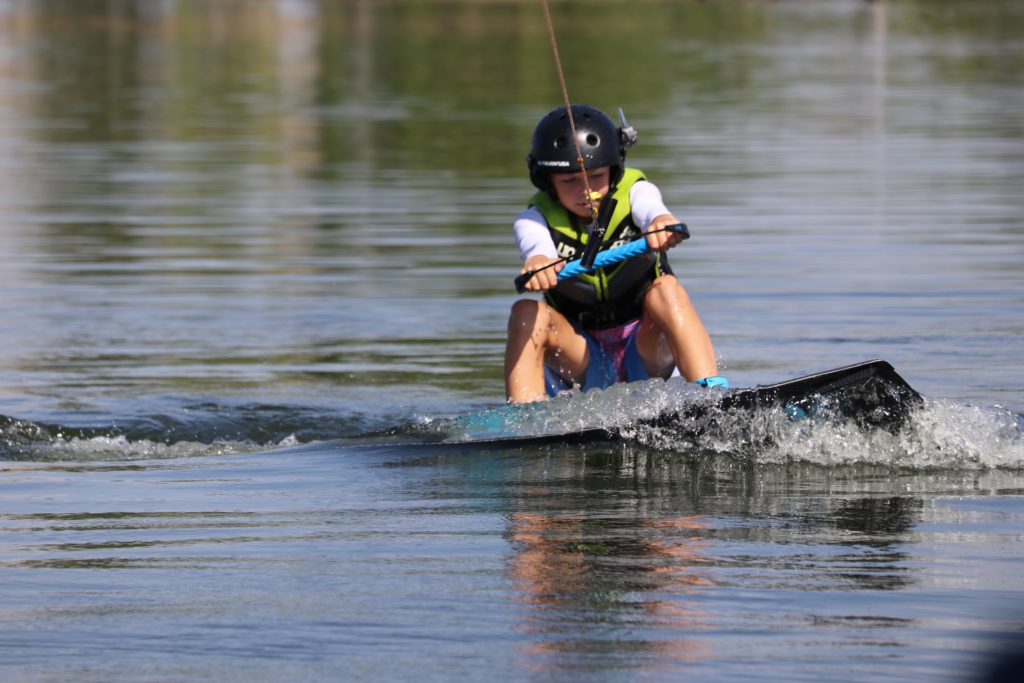
Photo Provided
Getting up on a wakeboard is like riding a bike. It’s a foreign concept at first, and you find yourself a little off-balance and shaky; but after awhile, it becomes second nature and you never have to think about it again.
Steps for Getting Up:
- Sit in the water with your knees slightly bent and your arms out straight on the outsides of your knees – the driver will make sure the line is tight.
- As the boat starts to accelerate, bend your knees and bring your butt to the board in a “catcher” position. Your knees should be bent and seen over the top of the board from the boat and your arms should remain straight.
- For larger adults, it helps to think about pushing your heels down to help tip the board into an angle that eliminates some of the pressure on your arms.
- The boat will then roll you forward and will allow the board to plane out as the boat accelerates a bit more. You’ll want your body directly over your board before standing. Slowly stand up and turn the board at a slight angle, leaning your weight against the rope for stability.
Don’t Fight it, Just Ride it!
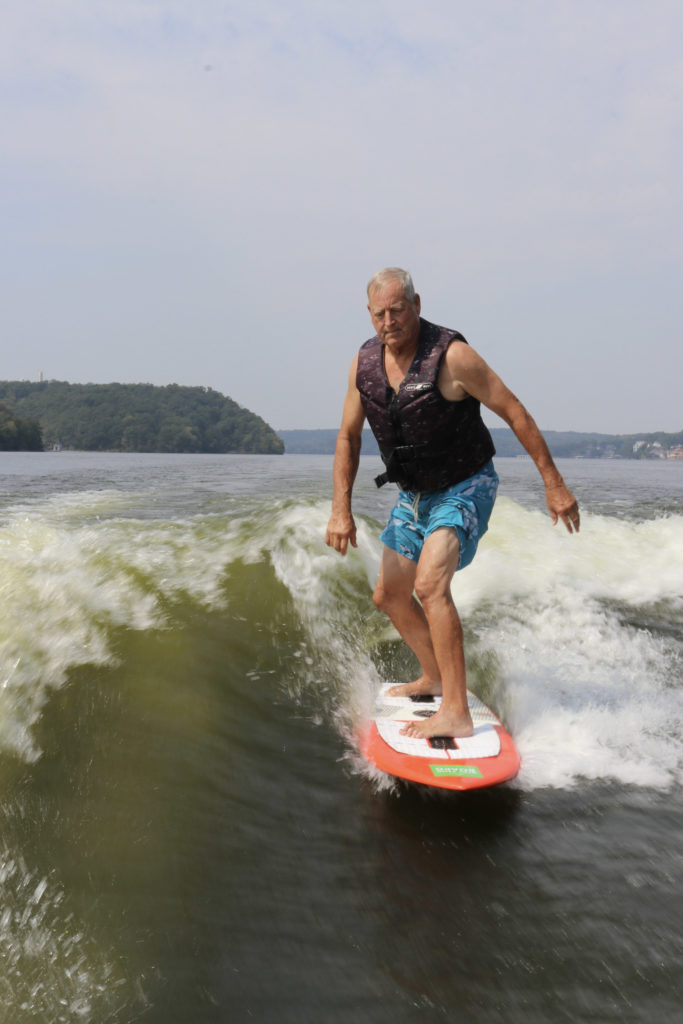
Photo by Sydney Liesmann, courtesy Kirbys School Of Wake
Wakeboarding is unique in that the technique to getting up is usually counterintuitive to most, especially if you have experience in traditional skiing. Many people feel they have to fight their way out of the water. But the key is to let the boat do the work. You’ll experience better results with less effort every time with a slow, controlled approach.
Here are a few common areas of struggle that will prevent you from achieving success getting up on a wakeboard. Consider this your guide on what not to do:
- Pulling on the rope
- Pushing your legs straight against the water
- Bending at the waist, rather than bending your knees
- Allowing your arms to slip down between the knees. This puts added strain on the hips and prevents the knees from bending
Learning watersports requires patience and positivity not just from the one learning, but also from everyone on board. Be patient with the learning process, and embrace the beauty of learning a new skill while knowing it may not be perfect the first time… and maybe not the second time, either! Don’t be afraid to try something new because you’re afraid to fail or look silly, and adopt a determined, “never quit” attitude. Practice thinking and speaking positively. Say you “can’t,” and you most likely won’t. Saying you can, pressing in, following the steps we’ve outlined, and achieving your goal: that will give you a wave of confidence and fulfillment that’s irreplaceable!
In a world of instant gratification, where we only truly connect by disconnecting from the never-ending digital tempest, watersports is an oasis of the good stuff in life. It’s a rare chance to unplug and let the cares of the world drift lazily by the wayside: to reset and refresh. We experience nature, prioritize genuine relationships, encourage one another with the reminder that there is greatness within us, and overcome fears together.
What are you waiting for? Go start creating the memories you’ll never want to forget.
